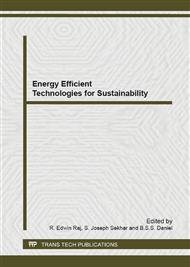[1]
K. Hussein, I. Muta, T. Hoshino, and M. Osakada, Maximum photovoltaic power tracking: An algorithm for rapidly changing atmosphere conditions, in Proc. Inst. Elect. Eng., vol. 142, p.59–64, Jan. (1995).
DOI: 10.1049/ip-gtd:19951577
Google Scholar
[2]
Trishan Esram, and Patrick L. Chapman, Comparison of Photovoltaic Array Maximum Power Point Tracking Techniques, IEEE transactions on energy conversion, vol. 22, no. 2, june (2007).
DOI: 10.1109/tec.2006.874230
Google Scholar
[3]
M. A. Masoum, H. Dehbonei, and E. F. Fuchs, Theoretical and experimental analyses of photovoltaic systems with voltage and current-based maximum power point tracking, IEEE Power Eng. Rev., vol. 22, no. 8, p.62–62, Oct. (2002).
DOI: 10.1109/mper.2002.4312477
Google Scholar
[4]
T. Noguchi, S. Togashi, and R. Nakamoto, Short-current pulse-based maximum-power-point tracking method for multiple photovoltaic-and converter module system, IEEE Trans. Ind. Electron., vol. 49, no. 1, p.217–223, Feb. (2002).
DOI: 10.1109/41.982265
Google Scholar
[5]
N. Femia, G. Petrone, G. Spagnuolo, and M. Vitelli, Optimization of perturb and observe maximum power point tracking method, IEEE Trans. Power Electron., vol. 20, no. 4, p.963–973, Jul. (2005).
DOI: 10.1109/tpel.2005.850975
Google Scholar
[6]
Mohammed A. Elgendy, Bashar Zahawi, and David J. Atkinson, Assessment of Perturb and Observe MPPT Algorithm Implementation Techniques for PV Pumping Applications, IEEE Trans. Sust. Energy, Vol. 3, No. 1, Jan. (2012).
DOI: 10.1109/tste.2011.2168245
Google Scholar
[7]
Ashish Pandey, Nivedita Dasgupta, and Ashok Kumar Mukerjee, High-Performance Algorithms for Drift Avoidance and Fast Tracking in Solar MPPT System, IEEE Trans Energy Conservation, Vol. 23, No. 2, Jun. (2008).
DOI: 10.1109/tec.2007.914201
Google Scholar
[8]
K. H. Hussein, I. Muta, T. Hoshino, and M. Osakada, Maximum photovoltaic power tracking: An algorithm for rapidly changing atmospheric conditions, Proc. Inst. Elect. Eng. —Gener., Transmiss. Distrib., vol. 142, no. 1, p.59–64, Jan. (1995).
DOI: 10.1049/ip-gtd:19951577
Google Scholar
[9]
Safari and S. Mekhilef, Simulation and hardware implementation of incremental conductance MPPT with direct control method using cuk converter, IEEE Trans. Ind. Electron., vol. 58, no. 4, p.1154–1161, Apr. (2011).
DOI: 10.1109/tie.2010.2048834
Google Scholar
[10]
Fangrui Liu, Shanxu Duan, Fei Liu, Bangyin Liu, and Yong Kang, A Variable Step Size INC MPPT Method for PV Systems, IEEE Trans. Indus. Elec., Vol. 55, No. 7, Jul. (2008).
DOI: 10.1109/tie.2008.920550
Google Scholar
[11]
Kashif Ishaque, Zainal Salam, A review of maximum power point tracking techniques of PV system for uniform insolation and partial shading condition, Renewable and Sustainable Energy Reviews 19 (2013) 475–488.
DOI: 10.1016/j.rser.2012.11.032
Google Scholar
[12]
K. Rai, N. D. Kaushika, B. Singh, and N. Agarwal, Simulation model of ANN based maximum power point tracking controller for solar PV system, Solar Energy Mater. Solar Cells, vol. 95, p.773–778, (2011).
DOI: 10.1016/j.solmat.2010.10.022
Google Scholar
[13]
N. Alajmi, K. H. Ahmed, S. J. Finney, and B. W. Williams, Fuzzylogic-control approach of a modified hill-climbing method for maximum power point in microgrid standalone photovoltaic system, IEEE Trans. Power Electron., vol. 26, no. 4, p.1022–1030, Apr. (2011).
DOI: 10.1109/tpel.2010.2090903
Google Scholar
[14]
Kashif Ishaque, Zainal Salam, Muhammad Amjad, and Saad Mekhilef, An Improved Particle Swarm Optimization (PSO)–Based MPPT for PV With Reduced Steady-State Oscillation, IEEE Trans Power Electronics, Vol. 27, No. 8, Aug. (2012).
DOI: 10.1109/tpel.2012.2185713
Google Scholar
[15]
Kashif Ishaque, Zainal Salam, Amir Shamsudin, Application of Particle Swarm Optimization for Maximum Power Point Tracking of PV System with Direct Control Method, IECON 2011 - 37th Annual Conference on IEEE Industrial Electronics Society, Nov. 2011, p.1214.
DOI: 10.1109/iecon.2011.6119482
Google Scholar
[16]
V. Phimmasone,Y. Kondo, T. Kamejima, and M. Miyatake, Evaluation of extracted energy from PV with PSO-basedMPPT against various types of solar irradiation changes, presented at the Int. Conf. Electrical Machines and Systems, Incheon, Korea, (2010).
Google Scholar
[17]
Y. Liu, D. Xia, and Z. He, MPPT of a PV system based on the particle swarm optimization, in Proc. 4th Int. Conf. Electric Utility Deregulation and Restruct. Power Technol., 2011, p.1094–1096.
DOI: 10.1109/drpt.2011.5994058
Google Scholar
[18]
Khouzam, K., L. Cuong, et al. (1994).
Google Scholar


